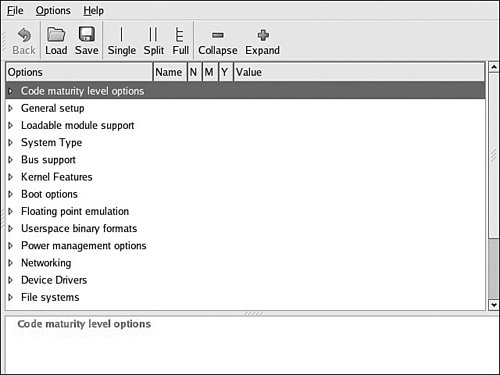Книга: Embedded Linux Primer: A Practical, Real-World Approach
4.3.2. Configuration Editor(s)
4.3.2. Configuration Editor(s)
Early kernels used a simple command line driven script to configure the kernel. This was cumbersome even for early kernels, in which the number of configuration parameters was much smaller. This command line style interface is still supported, but using it is tedious, to say the least. A typical configuration from a recent kernel requires answering more than 600 questions from the command line, entering your choice followed by the Enter key for each query from the script. Furthermore, if you make a mistake, there is no way to back up; you must start from the beginning again. That can be profoundly frustrating if you make a mistake on the 599th entry!
In some situations, such as building a kernel on an embedded system without graphics, using the command line configuration utility is unavoidable, but this author would go to great lengths to find a way around it.
The kernel-configuration subsystem uses several graphical front ends. In fact, a recent Linux kernel release included 10 such configuration targets. They are summarized here, from text taken directly from the output of make help :
• config Update current config using a line-oriented program
• menuconfig Update current config using a menu-based program
• xconfig Update current config using a QT-based front end
• gconfig Update current config using a GTK-based front end
• oldconfig Update current config using a provided .config as the base
• randconfig New config with random answer to all options
• defconfig New config with default answer to all options
• allmodconfig New config that selects modules, when possible
• allyesconfig New config in which all options are accepted with yes
• allnoconfig New minimal config
The first four of these makefile configuration targets invoke a form of configuration editor, as described in the list. Because of space considerations, we focus our discussion in this chapter and others only on the GTK-based graphical front end. Realize that you can use the configuration editor of your choice with the same results.
The configuration editor is invoked by entering the command make gconfig from the top-level kernel directory.[31] Figure 4-2 shows the top-level configuration menu presented to the developer when gconfig is run. From here, every available configuration parameter can be accessed to generate a custom kernel configuration.
Figure 4-2. Top-level kernel configuration

When the configuration editor is exited, you are prompted to save your changes. If you elect to save your changes, the global configuration file .config is updated (or created, if it does not already exist). This .config file, introduced earlier, drives the kernel build via the top-level makefile. You will notice in this makefile that the .config file is read directly by an include statement.
Most kernel software modules also read the configuration indirectly via the .config file as follows. During the build process, the .config file is processed into a C header file found in the .../include/linux directory, called autoconf.h. This is an automatically generated file and should never be edited directly because edits are lost each time a configuration editor is run. Many kernel source files include this file directly using the #include preprocessor directive. Listing 4-6 reproduces a section of this header file that corresponds to the earlier USB example above. Note that, for each entry in the .config file snippet in Listing 4-5, a corresponding entry is created in autoconf.h. This is how the source files in the kernel source tree reference the kernel configuration.
Listing 4-6. Linux autoconf.h
/*
* USB support
*/
#define CONFIG_USB_MODULE 1
#undef CONFIG_USB_DEBUG
/*
* Miscellaneous USB options
*/
#define CONFIG_USB_DEVICEFS 1
#undef CONFIG_USB_BANDWIDTH
#undef CONFIG_USB_DYNAMIC_MINORS
/*
* USB Host Controller Drivers
*/
#define CONFIG_USB_EHCI_HCD_MODULE 1
#undef CONFIG_USB_EHCI_SPLIT_ISO
#undef CONFIG_USB_EHCI_ROOT_HUB_TT
#define CONFIG_USB_OHCI_HCD_MODULE 1
#define CONFIG_USB_UHCI_HCD_MODULE 1
If you haven't already done so, execute make gconfig in your top-level kernel source directory, and poke around this configuration utility to see the large number of subsections and configuration options available to the Linux developer. As long as you don't explicitly save your changes, they are lost upon exiting the configuration editor and you can safely explore without modifying your kernel configuration.[32] Many configuration parameters contain helpful explanation text, which can add to your understanding of the different configuration options.
- DiskExplorer от Runtime Software
- Configuring xinetd for the wu-ftp Server
- 4.3. Kernel Build System
- Redirecting a special folder based on group membership
- Updating deployed software
- Optimizing Automatic Updates
- Exposing Multiple Endpoints
- 10.2.2.1 Caveat editor
- Memory-Related Registry Settings
- 10.2.1 Custom Versus .emacs
- Configuration options
- Acronis Disk Editor




